Check out the latest issue of MTU’s Trout Line newsletter! Read it online here or download a PDF for your favorite reading device. To join our mailing list, email [email protected].


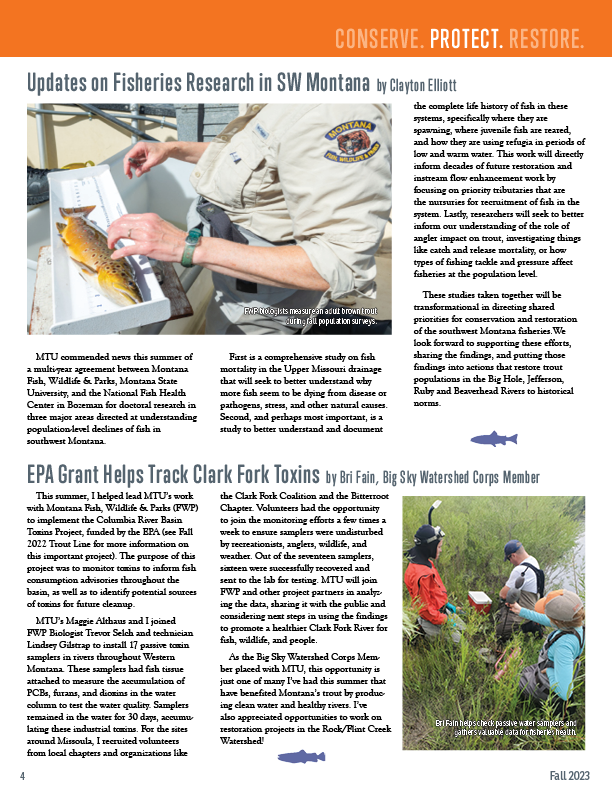

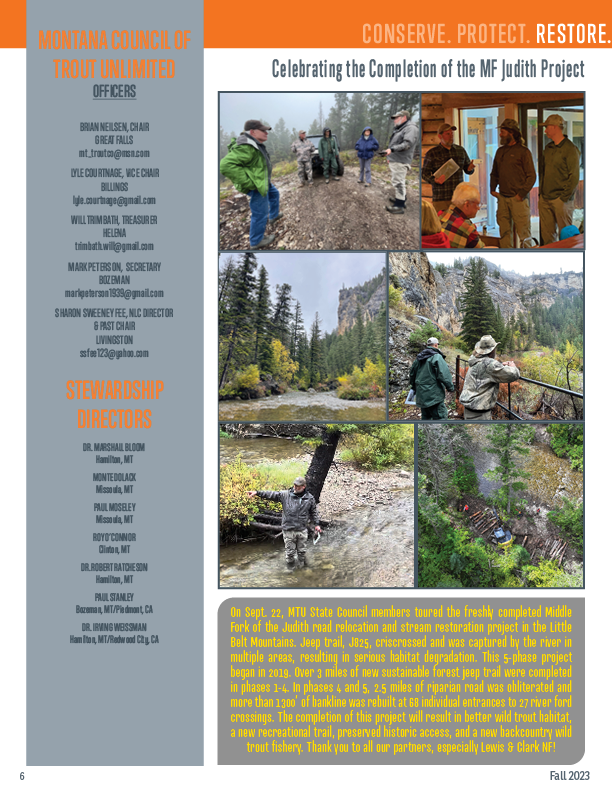
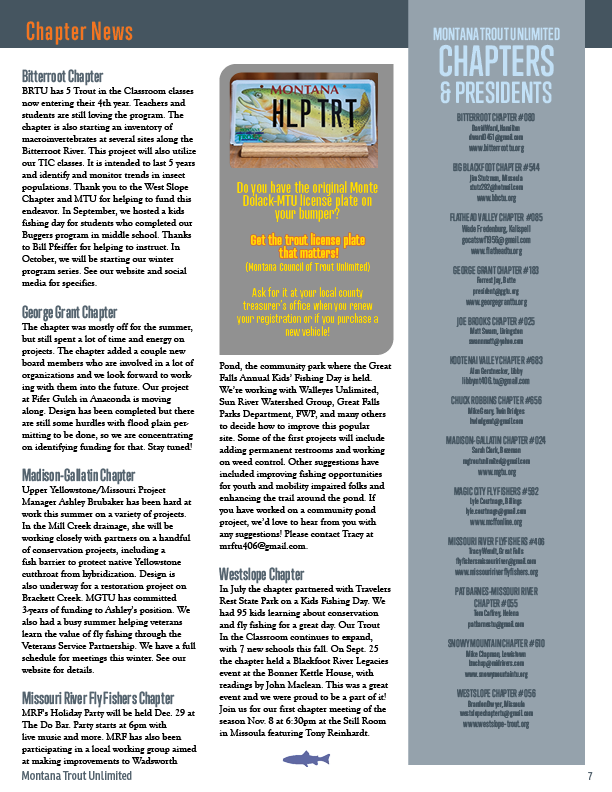
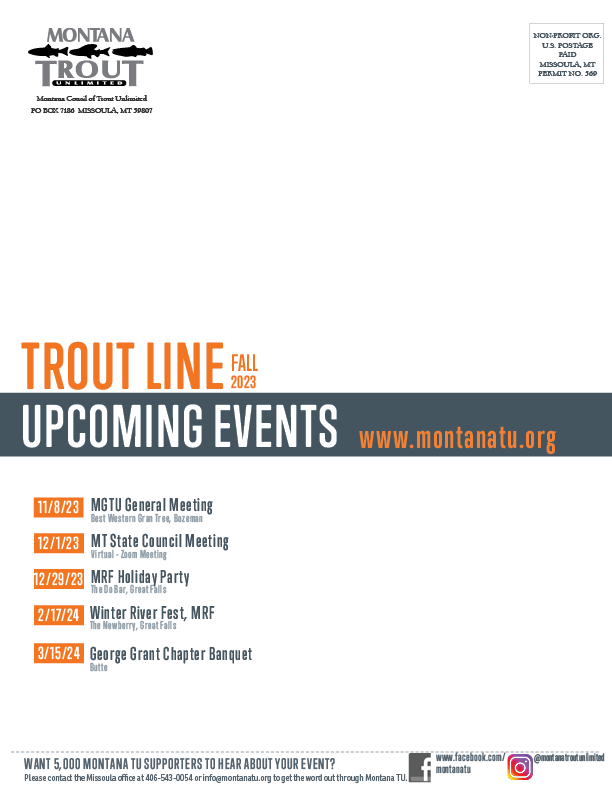

Check out the latest issue of MTU’s Trout Line newsletter! Read it online here or download a PDF for your favorite reading device. To join our mailing list, email [email protected].







Trout in the Jefferson River may have more access to spawning areas and thermal refuge thanks to a new partnership announced today by Montana Trout Unlimited (MTU) that will remove three aging diversion dams on the Boulder River. MTU is collaborating with Barrick Gold, owners of the Golden Sunlight Mine, with complimentary support from Montana Fish, Wildlife & Parks (FWP), Natural Resource Conservation Service (NRCS), and L.R. Huckaba Ranch on the Boulder River near Cardwell, MT to increase stream flow and connectivity on the Boulder.

“We commend Barrick and Golden Sunlight for taking a proactive approach to replace deteriorating infrastructure and for considering the potential benefits for the river and all the creatures that rely on it,” said Chris Edgington, MTU’s Jefferson Watershed Project Manager. “With trout numbers near, or at historic lows across much of Southwest Montana, there’s no better time for a water quantity and quality project in this area. This is a great example of the win-win projects Montana Trout Unlimited strives to develop.”
Rising in the mountains north of Butte, the Boulder River is the largest tributary to the Jefferson River downstream of the Beaverhead-Big Hole River confluence, providing a boost of cold water near the midpoint of the Jefferson’s 83-mile length. The Boulder is a high-value coldwater fishery and provides significant agricultural production in Jefferson County. On the Candlestick Ranch, the Shaw Diversion Dam and two smaller diversions deliver water to 233 acres of cropland. The aging infrastructure is getting more difficult to operate and regulate irrigation withdrawal. This project will alleviate infrastructure concerns, by removing the diversion dams and replacing them with instream irrigation pumps, thereby providing a significant ecological uplift to the Boulder and Jefferson Rivers through stream restoration, water savings, continued agricultural benefit, and wetland development.
“We are excited to partner with Montana Trout Unlimited in the removal of a diversion from the Boulder River. This collaborative effort will help to ensure a healthy and thriving fishery for future generations. Barrick’s dedication to our community as well as the surrounding wildlife exemplifies our commitment to building sustainable legacies,” said Kristine Murphy, Golden Sunlight General Manager.
“This project is a win-win for trout and property owners, and we couldn’t be more excited to see it get off the ground,” said Edgington.
In April 2021, the partners met to discuss the challenges at the project site, to share what resources they could provide, and what the potential outcomes of the project could be. MTU, along with FWP and NRCS, developed a plan to collect baseline data to quantify project benefits. Methods of data collection have included stream and irrigation flow monitoring, continuous temperature monitoring, fish population estimates, redd counts, juvenile trout out-migration surveys, and a wetland delineation.
Quantifiable project benefits include:
“The project adds about 7 CFS of summer flow to the Jefferson River, and Boulder River water is 2 to 3 °F cooler than the Jefferson during August,” said Ron Spoon, FWP Fisheries Biologist.
Planning, engineering, and design for the dam removal and stream restoration will begin this fall. The partners anticipate project implementation in the fall/winter of 2025. For more information on this project, contact Chris Edgington at [email protected].
Our Summer 2023 Trout Line Newsletter is out now. Read it online here or download a PDF version for your favorite reading applications.


CENTENNIAL GRAYLING UPDATE: Unfortunately, after this issue went to print, federal District Judge Donald Molloy granted an injunction to stop the project until the case is fully heard, which likely means no project to benefit these grayling in 2023. This delay and its proponents stand to have far greater negative impacts to this Wilderness ecosystem by risking the disappearance of one of the most unique and iconic species than the short and modest construction efforts implementing the project in a Wilderness area would entail. This is a blow to the grayling, the spirit of collaborative conservation and Wilderness character. We remain optimistic that the Refuge decision and project will prevail on full hearing, assuming grayling survive another winter without our help. Stay tuned for more developments.
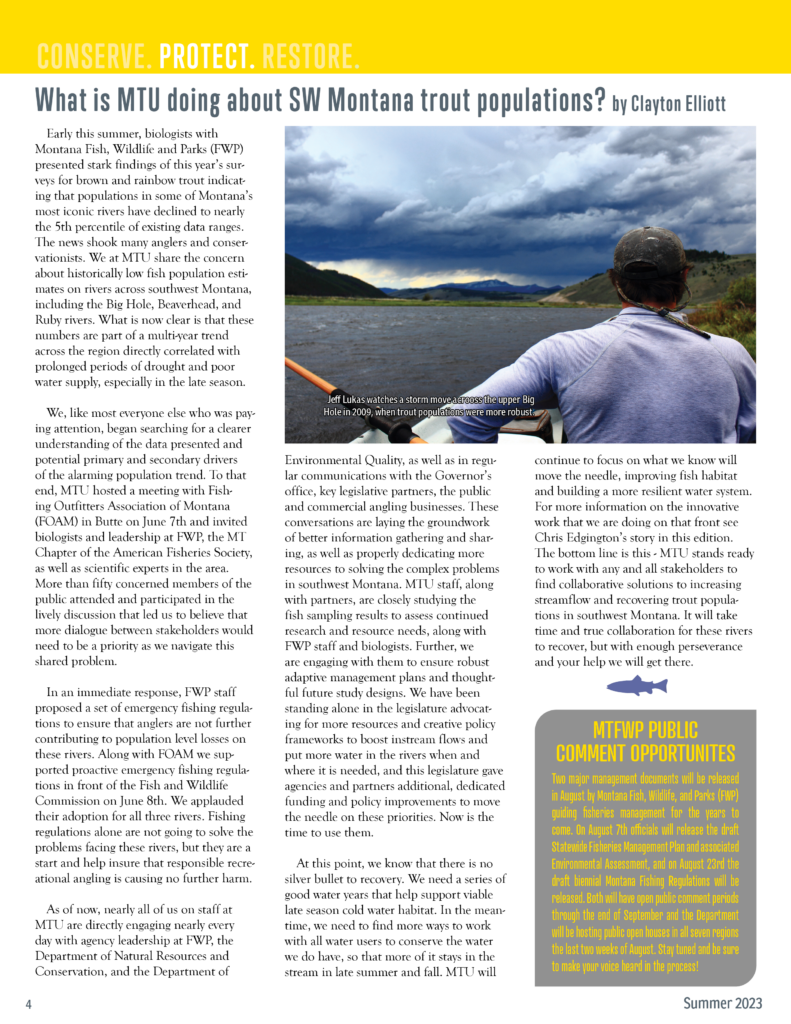
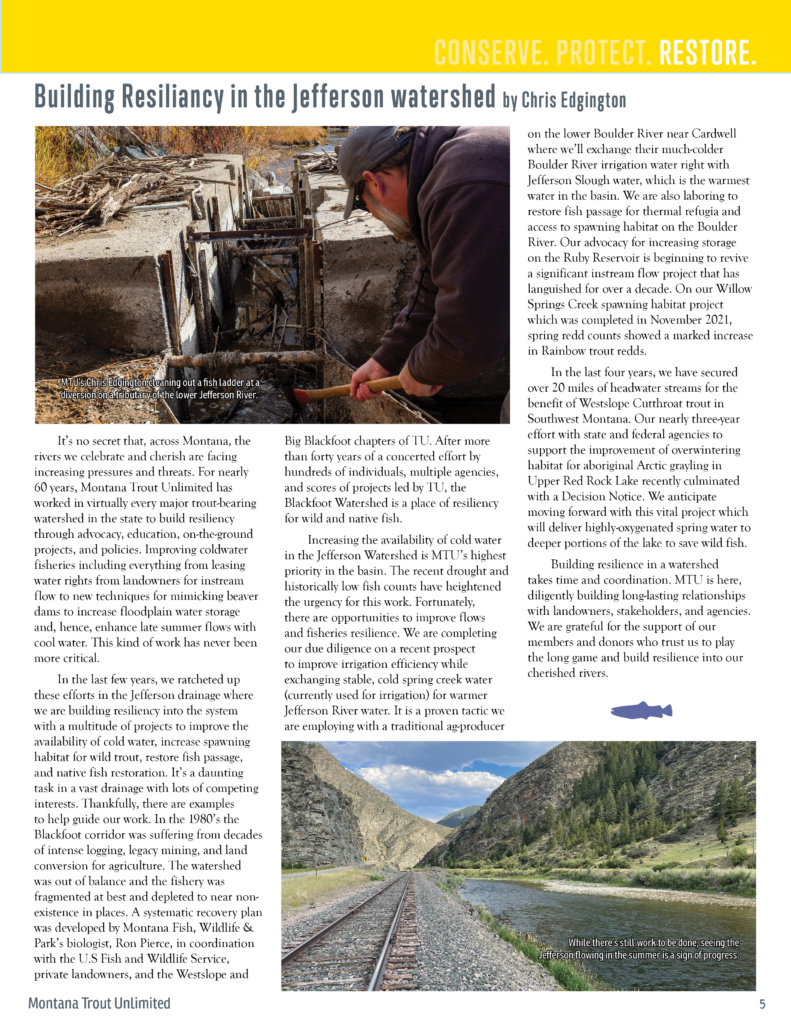
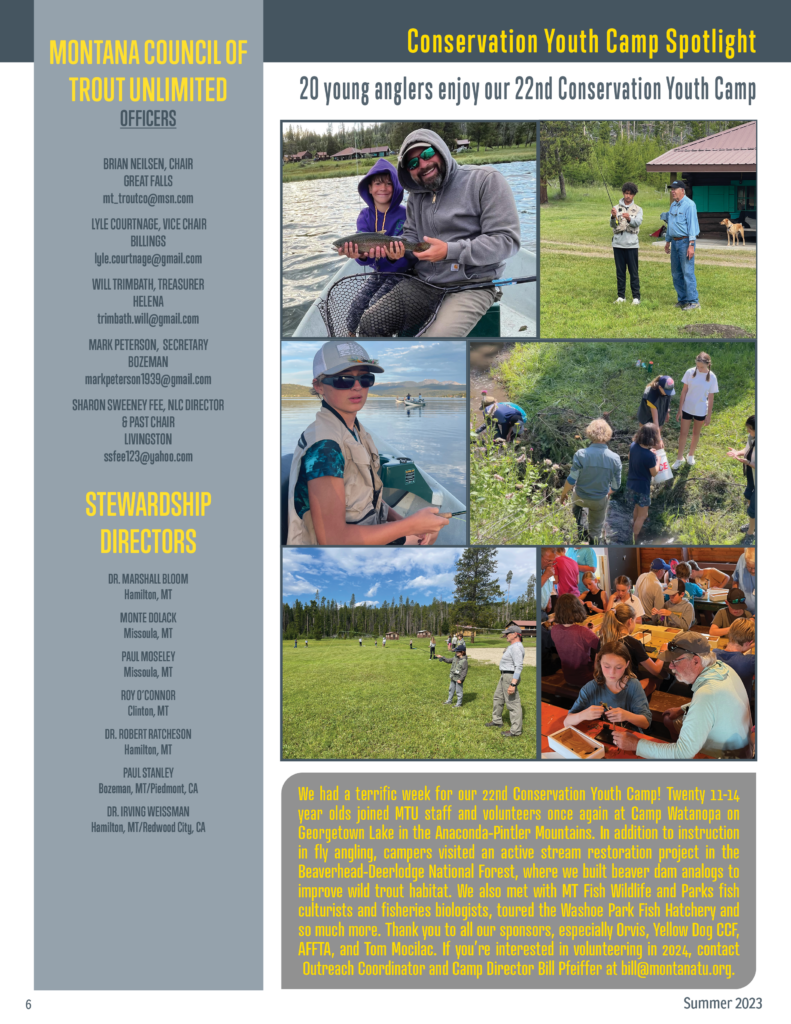


Our Spring 2023 Trout Line Newsletter is out now, with a special 2022 Annual Report insert. Read it online here or download a PDF version for your favorite reading applications.
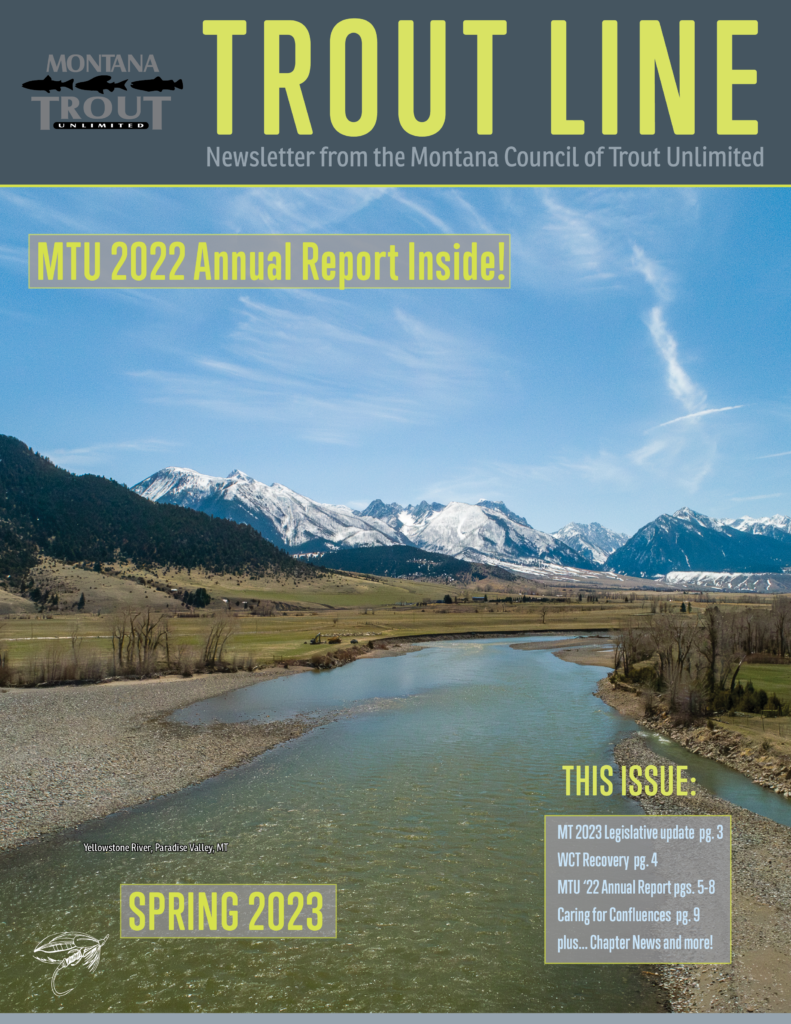
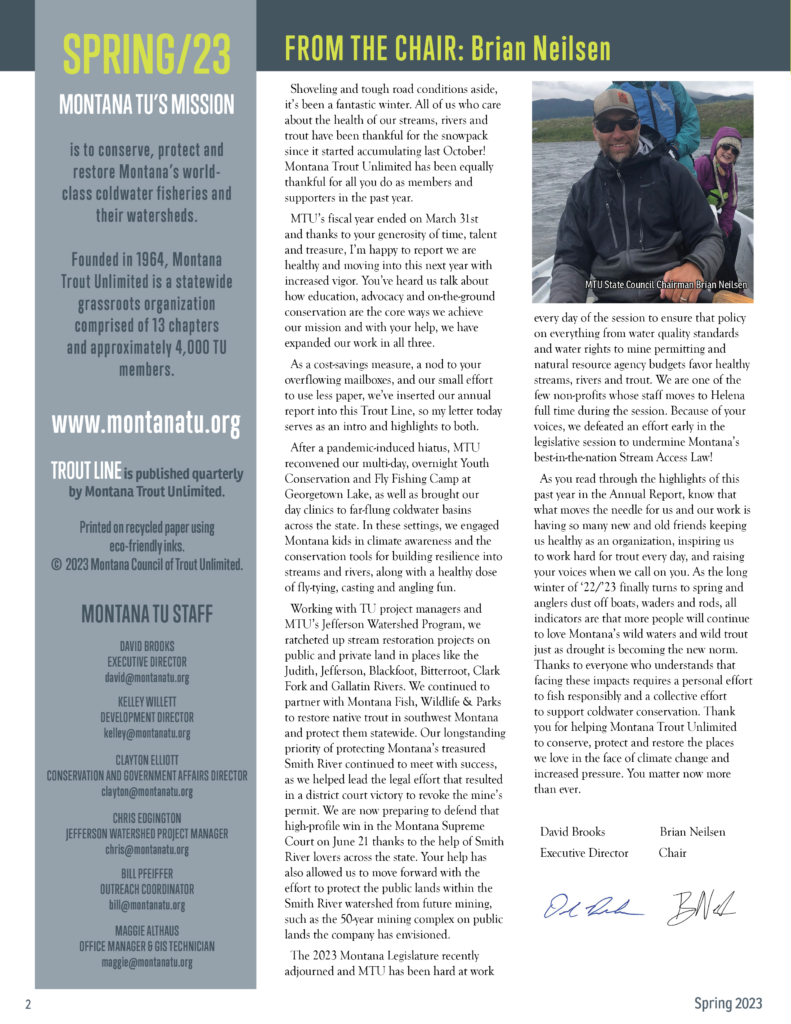
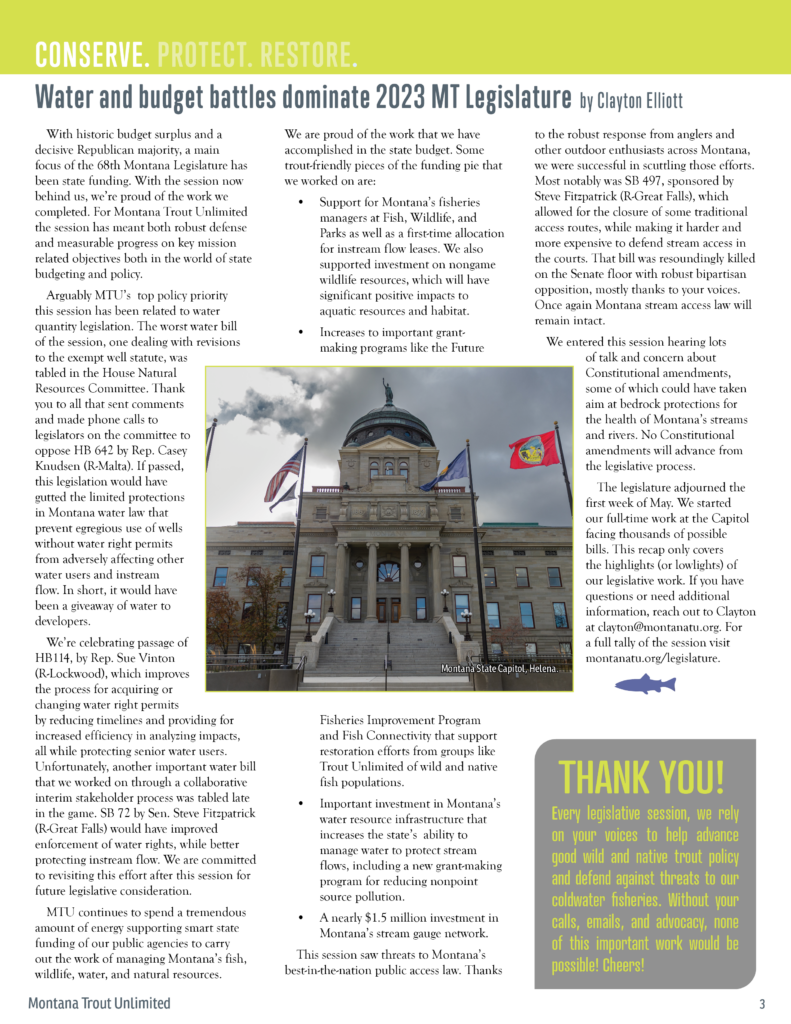
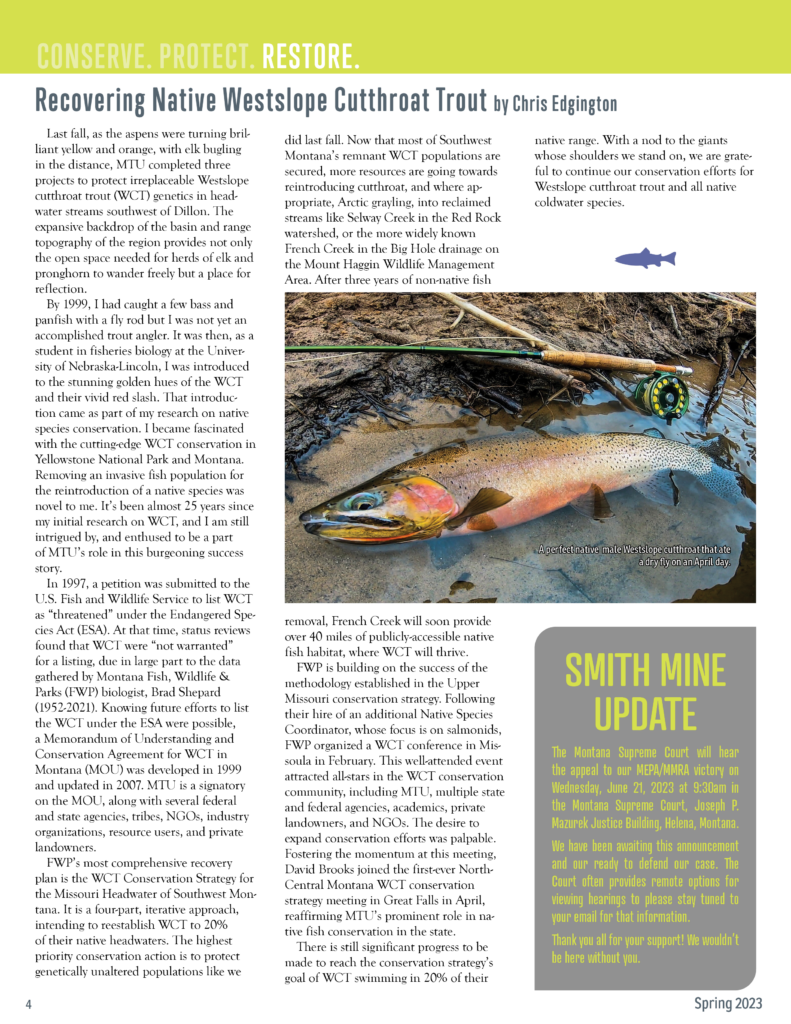

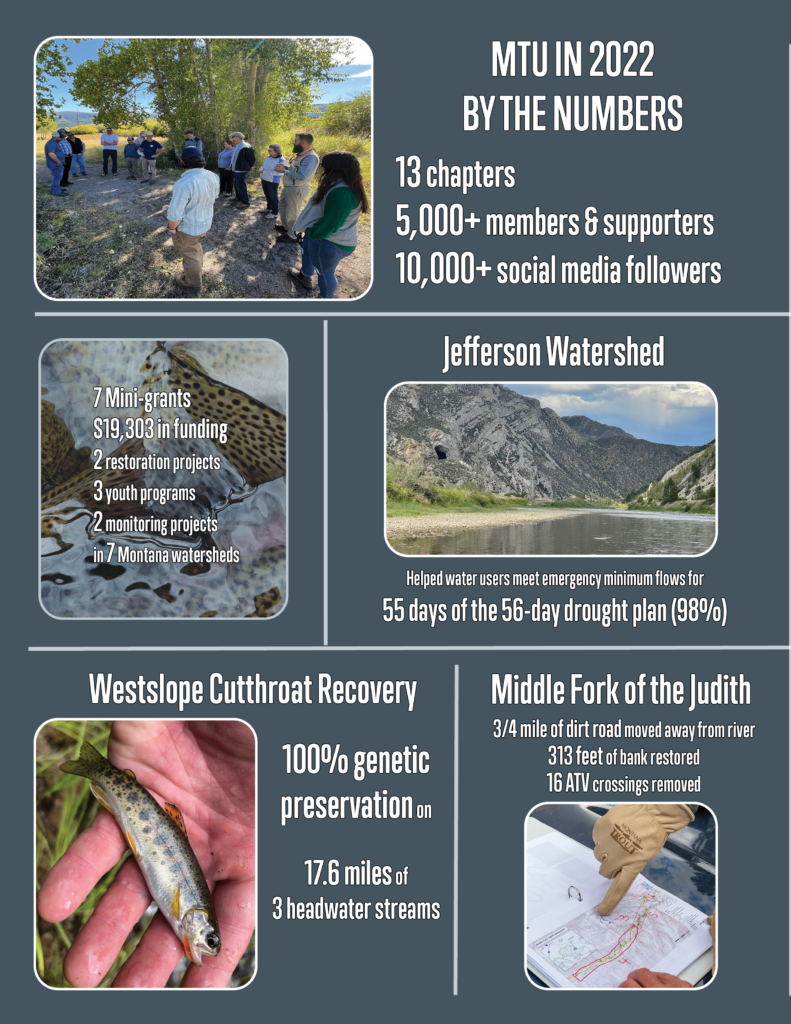

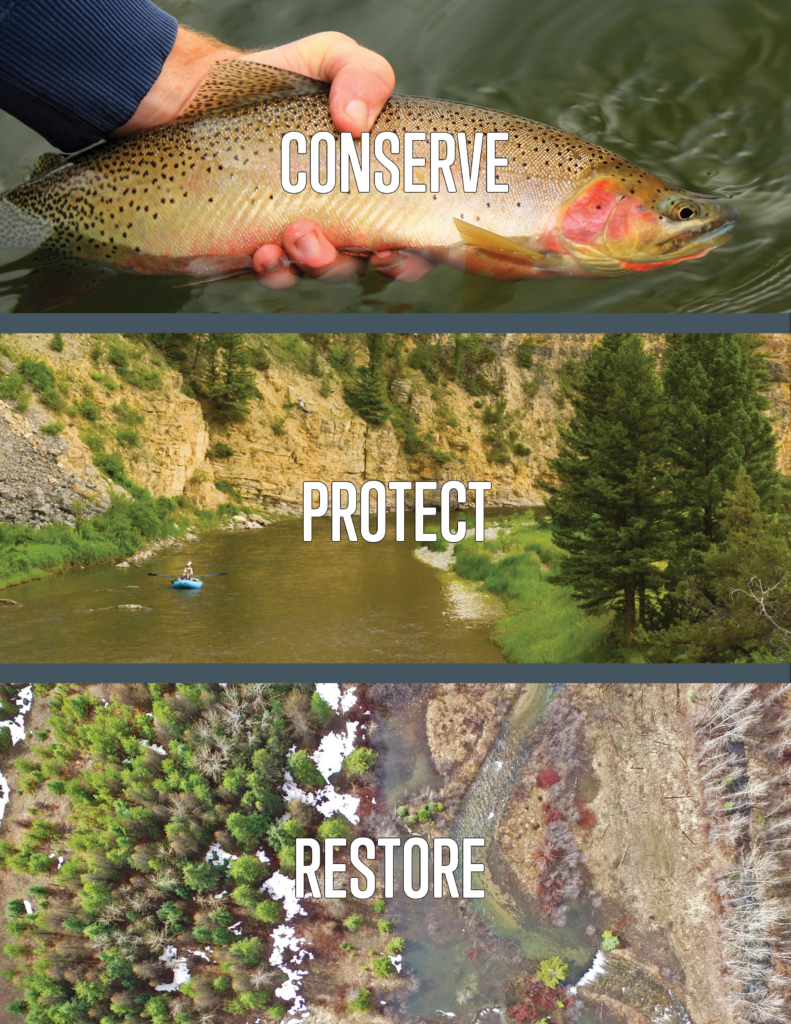
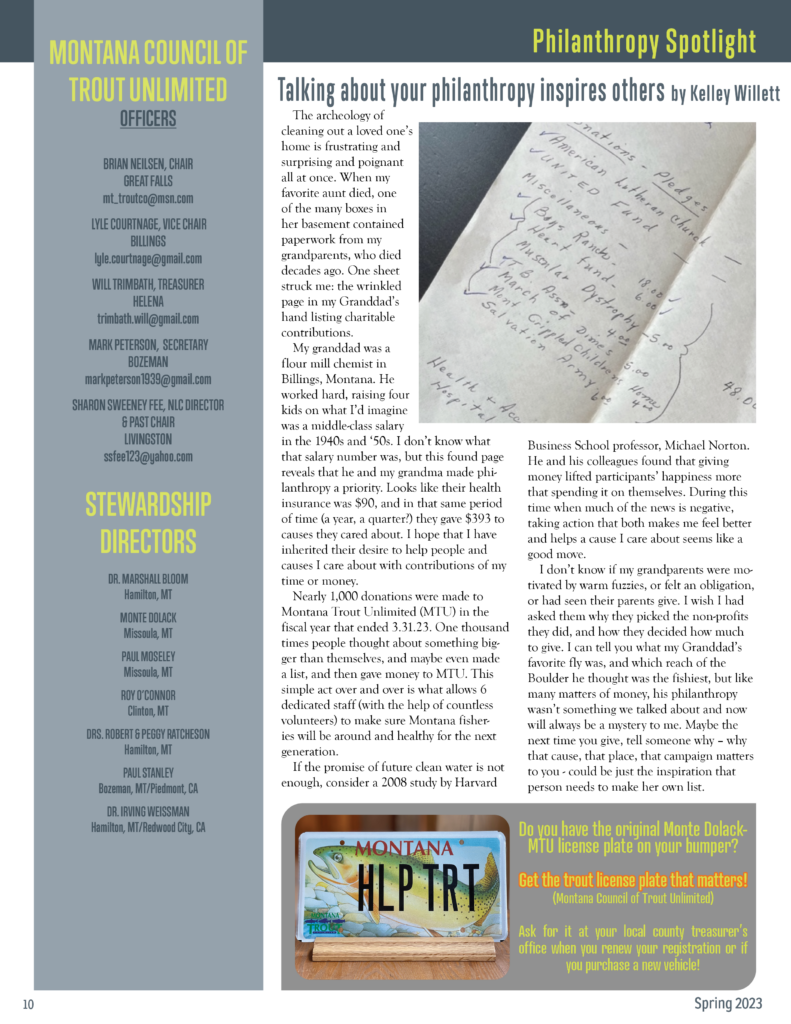
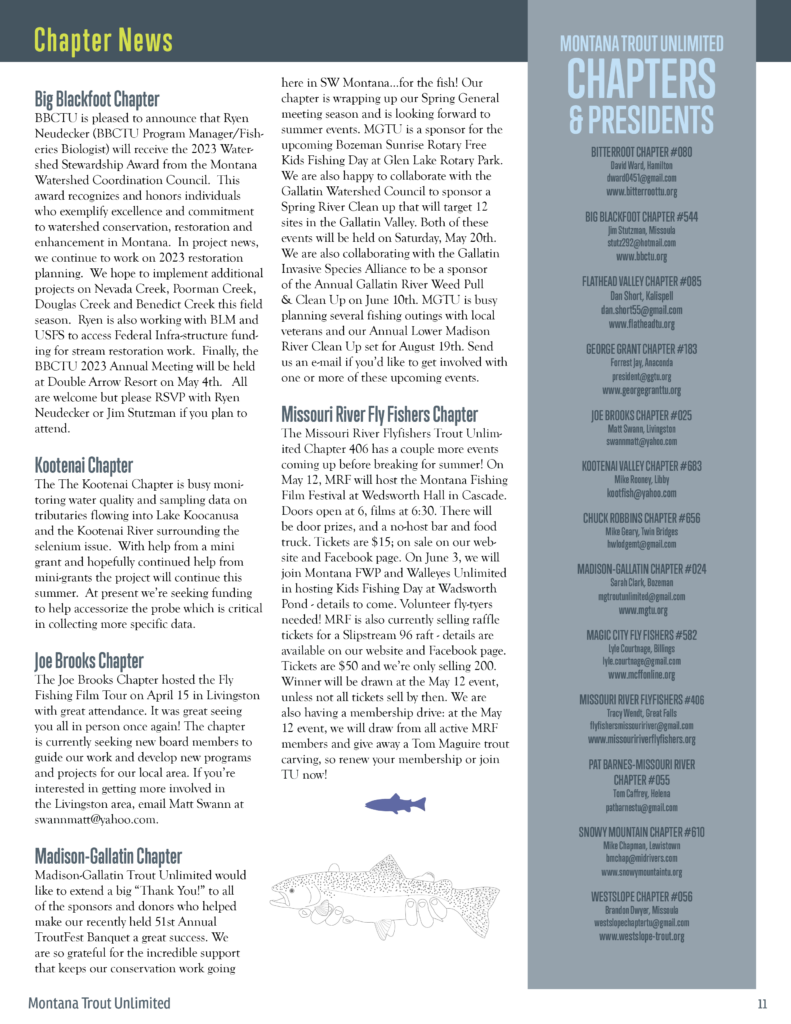
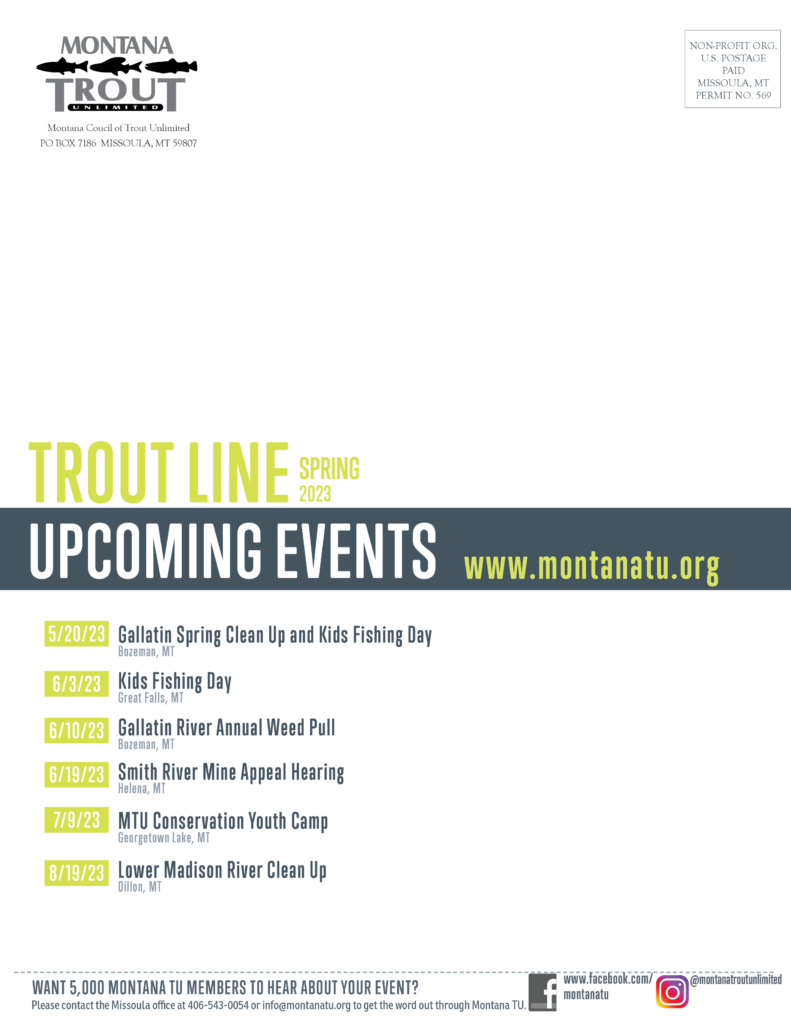
We need your help to protect Montana’s wild trout and coldwater fisheries from an egregious water bill that could dewater trout streams. Contact your state Representative and ask them to vote NO on House Bill 642 immediately!
HB642 is an end-run around Montana water law and one of the most dangerous bill for Montana’s trout streams this session. Of the more than 2000 bills that have been floated at the Montana Legislature this session, this is the worst water related bill if you’re a trout, care about trout, or care about traditional water uses in Montana. Here are just a few of the issues with this bill:
For a deeper dive into the legal aspects of this bill, check out our FAQ sheet here.
These are just a few of the problems with this bad bill. The bill received broad opposition in its hearing on February 22nd – from agriculture to municipalities to power companies and conservation organizations. The bottom line is HB642 is bad for wild trout and traditional existing senior water users in Montana and could result in less cold water in our streams and rivers at a time when the demand for Montana’s water resources are increasing exponentially and persistent drought is rapidly decreasing the water supply in our state.
You can help!
HB 642 WILL BE VOTED ON THE WEEK OF MARCH 27, 2023 IN THE HOUSE NATURAL RESOURCES COMMITTEE! If you care about Montana’s wild trout streams and want to pass them on to the next generation, let your representative know that you strongly oppose HB642 today!
To find your Representative’s contact information, click the TAKE ACTION button or HERE. Locate and then click on your place of residence on the map by using the ‘+’ and ‘-‘ symbols to zoom. Your representative’s contact info will be displayed in a pop-up dialog box. Please call or email them as soon as possible and tell them to protect Montana stream flows and wild trout. For sample language for your comment see below:
SAMPLE COMMENT
Dear Representative,
As one of your constituents, I respectfully ask you to vote NO on HB642. This bill will have profoundly negative impacts for trout streams, instream flows, and water rights holders. It expands permit exemptions at a time when water is more precious than ever before. We need to safeguard our water for wildlife, agriculture, and recreation. Please vote no on this bill and help preserve our Montana heritage.
Thank you,
YOUR NAME
Arctic grayling are one of Montana’s most iconic and imperiled native fish and they might soon be gone from one of their last refuges. The Upper Red Rock Lake (URRL) population of grayling have declined to the point that without direct intervention, they may soon disappear entirely. We need your help and support to solve this problem and protect URRL native grayling for future generations.
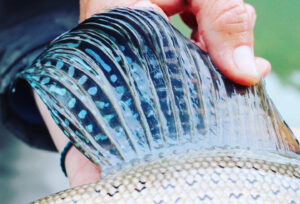
The problem for grayling in URRL is a lack of oxygen during the winter. Oxygen levels below the ice of the lake fall into the lethal range for grayling. More than a decade of research by USFWS, FWP and many partners leads to the clear conclusion that these fish will vanish unless we find a way to increase oxygen-rich water under the snow and ice cover of Upper Red Rock Lake.
The US Fish & Wildlife Service (USFWS), Fish Wildlife & Parks (FWP), and many partners evaluated dozens of project alternatives, leading to a draft Environmental Assessment (EA) outlining six viable options for saving these grayling. This draft EA is now out for public comment. The USFWS and Red Rock Lakes National Wildlife Refuge decision-makers need to hear from you in support of project alternatives aimed at long-lasting grayling conservation.
Tell USFWS today that ‘No Action’ is not a viable alternative. MTU encourages the agencies to pick a solution providing the most sustainable overwinter habitat for grayling while having the lease and shortest-term impacts to the Refuge and Wilderness.
Given the urgency for grayling, we believe that the underwater diffusers and/or the Shambow pipeline are the bests options for immediate implementation. We believe one, or both of these projects, concurrently or in sequence are needed. Failing to implement a project risks the survival of these grayling, as well as a failure to uphold the values and goals of the Refuge and Wilderness.
View the draft EA HERE. To send your comment via email, click here. For help, check out our sample comment below. You can also mail a letter to:
Elizabeth Tsang U.S. Fish & Wildlife Service, NWRS Planning Division PO Box 25486 DFC Denver, CO 80225
Comments are due by March 28, 2023. As always, if you have any questions about our work, please reach out to us directly at [email protected].
SAMPLE COMMENT
Dear Ms. Tsang,
I believe immediate action should be taken by the USFWS to protect Upper Red Rock Lake grayling. The ‘No Action’ alternative will result in the extirpation of this population. I encourage you to select an alternative to increase overwinter habitat that will have minimal impacts to the Refuge and Wilderness.
Specifically, I believe that underwater diffusers and the Shambow pipeline to be the best options to save these special fish and one or both in succession should be implemented. Thank you for your time and consideration.
Sincerely,
[Your Name Here]